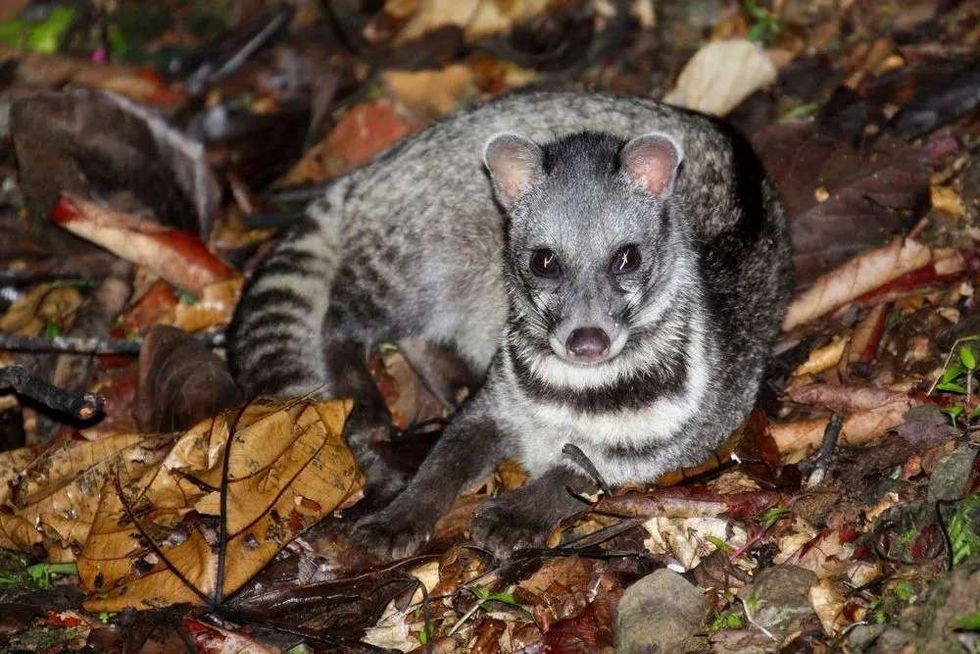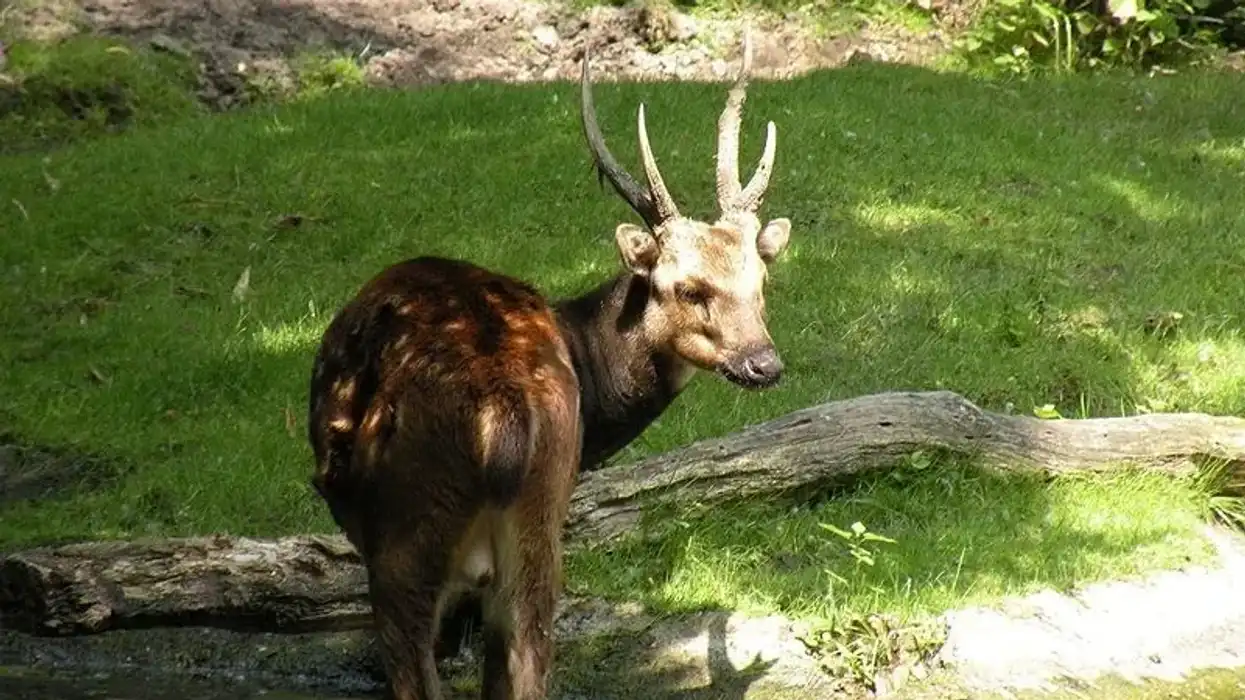The Malayan civet (also known as the oriental civet) is a species of civet that is mainly found in the Malay Peninsula and on the islands of Borneo, the Riau Archipelago, and the Philippines. Malayan civets are solitary in nature as a species.
They stay hidden and pounce on their prey by surprise. The Malayan civet (oriental civet) belongs to the family Viverridae, genus Viverra and they're 23-37 in (58.5-95 cm) long and weigh around 3-10 lb (1.4-4.5 kg).
Some interesting facts about Malayan civets describe how they have grayish, brown, pale, and tawny fur with black spots. They have a long tail that is 11.8-19 in (30-48.2 cm) in length and is marked with black bands, which provide excellent camouflage.
Although Malayan civets belong to the order Carnivora, they are omnivores as their diet includes both fruits as well as other animals. The Malayan civet (oriental civet) species has a wide variety of habitats. They can be found in both grasslands and forests.
Here are some amazing and interesting fun facts about the Malayan civet species for you to enjoy. Let's take a look at these Malayan Civet facts and information, and if you enjoy these then, do read our guide to the pademelon and the fennec fox for more amazing facts and information about different animals.
Malayan Civet Interesting Facts
What type of animal is a Malayan civet?
The oriental civet (Malayan civet) is a species of civet cat found in the Malay Peninsula and is known to be native to Malaysia and the islands around it, such as Borneo, the Riau Archipelago and the Philippines. The scientific name of a Malayan civit is Viverra tangalunga.
What class of animal does a Malayan civet belong to?
The Malay civet species (Viverra tangalunga) belongs to the class Mammalia. They're good predators and surprise their prey by pouncing on them from behind. They can achieve a good camouflage thanks to the black bands and spots present on their body.
How many Malayan civets are there in the world?
According to the IUCN red list, the Malayan civet cat species has the conservation status of Least Concern. However, the exact population of oriental civets in the world is unknown as they are solitary who stay hidden by nature, making it difficult to estimate their population.
Where does a Malayan civet live?
A Malay civet (Viverra tangalunga) lives in grasslands and forests and is likely to be found in the Malay Peninsula. This species is native to Malaysia and the islands around it.
What is a Malayan civet's habitat?
An oriental civet (Malayan Civet) lives in a wide variety of habitats such as grasslands, forests, brushes, and mountain forests. These areas are rather dense and help them to hide and blend in with their habitat.
Moreover, these areas are filled with fruits, roots, insects, and small animals, all of which make up an important part of the Malayan civet's diet, so there is an abundance of food available for the Malay civet (Viverra tangalunga) in its habitat.
Who do Malayan civets live with?
Malayan civets are solitary animals and usually live alone. Malayan civet males and females only meet during mating seasons.
How long does a Malayan civet live?
An oriental civet (Malay civet) has a lifespan of five to 12 years, but they can live up to 20 years of age in some cases. Many older Malayan civets are recorded to have an age between 15 and 20 years.
How do they reproduce?
Malay Civet (Viverra tangalunga) males and females meet for the purpose of mating only. Females are capable of giving birth twice a year and their gestation period only lasts for a couple of months. Females give birth in dense vegetation, holes in the ground, and hollow tree trunks.
What is their conservation status?
The oriental civet (Malayan civet)'s status is currently Least Concern. Their population number is unknown, but the species is believed to be stable and they are not in danger of becoming extinct.
Malayan Civet Fun Facts
What do Malayan civets look like?
The Malay civet (Viverra tangalunga) belongs to the Animalia kingdom. They have brown, yellow, grayish fur and black spots all over their body.
They have a long tail that is about 11.8-19 in (30-48.2 cm) long. Black stripes or bands are present on the Malayan civet's back and tail, which help the civet to remain camouflaged in its habitat to hide from predators or to hunt other animals. It has a sleek, long body with whiskers.

*Please note that this is an image of a civet, not a Malayan civet specifically. If you have an image of a Malayan civet please let us know at hello@kidadl.com.
How cute are they?
The Malay civet (Viverra tangalunga) is a cute and small animal. They are generally calm in nature and do not attack or get aggressive unless they feel threatened or cornered. All the animals that belong to the species Viverra are really cute and are generally harmless.
How do they communicate?
The oriental civet (Malayan civet) sometimes makes small meow-like sounds, but they predominantly communicate with other Malayan civets using scent. They secrete a smell from their anal glands called 'civet' or 'civetone' and communicate and warn other civets using this scent.
How big is a Malayan civet?
The average Malayan civet size is between 22-37 in (58.5-95 cm) in length and 17-28 in (43-71 cm) tall. Malayan civets are quite small animals, and their tail is around 11-19 in (30-48.2 cm) long. A tiger is between four and five times bigger than a Malayan civet and can easily hunt it.
How fast can a Malayan civet run?
The speed of Malayan civets has not been tracked officially as they are rarely spotted running in the open. Despite this, we do know that their black spots help them blend in with their habitat and hunt more efficiently. They don't run behind their prey, instead, they hide and perform a surprise attack.
How much does a Malayan civet weigh?
Malayan civets only weigh around 3-10 lb (1.4-4.5 kg). They are small and light animals that have a variety of habitats in Malaysia and its surrounding islands. They use their small size to hide and hunt effectively.
What are their male and female names of the species?
Male and female Malayan civets do not have separate names. They all belong to the species Viverra, the order Carnivora, and the kingdom Animalia.
What would you call a baby Malayan civet?
A baby Malayan civet (Viverra tangalunga) is sometimes referred to as a 'kitten' but they do not have a specific name other than this.
What do they eat?
Malayan civets belong to the order Carnivora, but their diet suggests that they are actually omnivores. Their diet includes insects, snakes, lizards, and birds. They also eat different fruits such as mangoes and bananas. They are also seen eating some roots and seed pods from trees.
Are they aggressive?
Malayan civets are calm and non-aggressive animals. They are friendly and do not attack without a good reason. However, they might become aggressive if they are threatened or are cornered in a situation. They are generally seen as a pest in Malaysia as they steal fruits, livestock, and poultry.
Would they make a good pet?
Malayan civets are calm animals that are valued for their musk which is used in making medicines and perfumes. Malayan civets are sometimes tamed by humans, but because they are wild animals, keeping them as a pet requires a special license.
Did you know...
Cannibalism has been observed in Malayan civets. Mothers can eat their young soon after they are born.
Malayan civets are often kept with other civets in zoos, and their enclosures are designed like their natural habitats to include a lot of tall grasses, shrubbery, and hiding places. Young Malayan civets require a lot of care after being rescued and often live up to only 12 years in captivity.
Their long tail is marked with black bands, which provides excellent camouflage and helps them when hiding as well as hunting.
They are found in Malaysia and were first introduced in the Maluku islands, near Malaysia. They are often treated as a pest by Malaysians because they steal from poultry and livestock. Villagers have the authority to shoot them if they destroy their poultry.
Are civets related to cats?
Civets are often referred to as civet cats, maybe because they look similar and have the same strong odor as cats, but they are more closely related to a mongoose than a cat. However, they are a part of a group called 'Feliforma'.
This means 'cat-like' and is a suborder of the order carnivore. Cats and mongoose are both part of the Feliforma group, alongside civets.
Is a civet a fox?
No, a civet is not a fox. It might look like a cat or fox, but it is not in any way related to a fox. In fact, it has more similarities to a mongoose than a fox.
Here at Kidadl, we have carefully created lots of interesting family-friendly animal facts for everyone to discover! Learn more about some other mammals, including the Mexican wolf, or the northern short-tailed shrew.
You can even occupy yourself at home by drawing one on our Malayan Civet coloring page.









